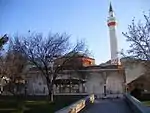Hüsnüşah Hatun
Hüsnüşah Hatun (Ottoman Turkish: حسنی شاہ خاتون; died c. 1513), was a consort of Sultan Bayezid II of the Ottoman Empire.
| Hüsnüşah Hatun | |
|---|---|
| Born | Karamanid Principality |
| Died | c. 1513 Bursa, Ottoman Empire |
| Burial | |
| Spouse | Bayezid II |
| Issue | Şehzade Şehinşah Sultanzade Hatun |
| Father | Nasuh Bey |
| Religion | Sunni Islam |

Family
Hüsnüşah Hatun was the daughter of Nasuh Bey,[1] the maternal grandson of Ibrahim II Bey, ruler of the Karamanids, and the governor of İçil.[2][3] She had two brothers named Pir Ahmed Bey, and Abdülkerim Bey.[4]
Marriage
Hüsnüşah married Bayezid when he was still a prince, and the governor of Amasya sanjak. She gave birth to two children, a son, Şehzade Şehinşah in 1461,[1] and a daughter, Sultanzade Hatun.[5][6]
According to Turkish tradition, all princes were expected to work as provincial governors as a part of their training. In 1481 Şehinşah, was sent to Manisa sanjak, and then in 1485 to Karaman, and Hüsnüşah accompanied him. She built and endowed a mosque in 1490,[7][5][1][8] and Kurşunlu Han in 1497 at Manisa.[9] She also made several endowments in memory of her ancestors.[10]
After Şehzade Şehinşah's execution in 1511, Hüsnüşah in a letter reported that she had been rendered crazy following his execution, defended his innocence, and requested that a mausoleum be built in his memory.[11] She also corresponded with Selim I, Şehinşah's victorious brother, on behalf of Mevlana Pir Ahmed Çelebi, a scholar who had been at Şehinşah's court and who was neglected when the members of the prince's household were assigned new posts.[12]
Death
Hüsnüşah Hatun died at Bursa in 1513, and was buried in Muradiye Complex.[1][6][5][13]
References
- Uluçay, M. Çağatay. BAYAZID II. IN ÂILESI. pp. 108, 109, 116–17.
- Kılınç, Emin. Klâsik Osmanlı Eğitim Kurumlarından Konya Dârü’l-Huffâzları ( XVII. Yüzyıl). p. 35.
- Al-Tikriti 2004, p. 313 n. 82.
- Konyalı, Ibrahim Hakkı (2007). Konya Tarihi. pp. 171–72.
- Uluçay 2011, p. 46.
- Sakaoğlu 2008, p. 188.
- Peirce 1993, p. 52-53.
- Sakaoğlu 2008, p. 188-89.
- Al-Tikriti 2004, p. 73.
- Al-Tikriti 2004, p. 55 n. 25.
- Al-Tikriti 2004, p. 314 n. 87.
- Peirce 1993, p. 50.
- Raif Kaplanoğlu (1998). Bursalı şair, yazar, ve ünlüler ansiklopedisi. Avrasya Etnografya Vakfı. p. 212.
Sources
- Al-Tikriti, Nabil Sirri (2004). Şehzade Korkud (ca. 1468-1513) and the Articulation of Early 16th Century Ottoman Religious Identity – Volume 1 and 2.
- Peirce, Leslie P. (1993). The Imperial Harem: Women and Sovereignty in the Ottoman Empire. Oxford University Press. ISBN 978-0-195-08677-5.
- Sakaoğlu, Necdet (2008). Bu mülkün kadın sultanları: Vâlide sultanlar, hâtunlar, hasekiler, kadınefendiler, sultanefendiler. Oğlak Yayıncılık. ISBN 978-9-753-29623-6.
- Uluçay, Mustafa Çağatay (2011). Padişahların kadınları ve kızları. Ankara: Ötüken. ISBN 978-9-754-37840-5.
